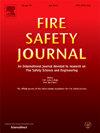Study on the applicability of scaling laws in tunnel fires under natural ventilation conditions
IF 3.4
3区 工程技术
Q2 ENGINEERING, CIVIL
引用次数: 0
Abstract
This article numerically investigates the impact of tunnel scale ratio and fire Heat Release Rate (HRR) on the scaling results of temperature distribution and smoke field in a tunnel under natural ventilation conditions, by preserving Froude (Fr) scaling. Computational fluid dynamics simulations were performed on a 1:8 scale physical tunnel model [1], showing satisfactory agreement between measured data and predicted results. On this basis, four additional numerical models with scales of 1:1, 1:2, 1:4, and 1:16 were built based on Froude scaling principles, considering the scaling of thermal properties of materials and wall thickness. Four HRRs ranging from 3 MW to 50 MW were adopted. The simulation results provide insights into the temperature and flow fields, revealing the influence of tunnel scale ratio, HRR, and wall scaling method on scaling errors. Significant discrepancies found in the smallest tunnel model with a scale ratio of 1:16 were well explained by transitional or laminar flow due to low Reynolds number (Re), which can primarily cause a significant reduction in ceiling jet temperature as well as an increase in smoke arrival time and smoke thickness. Finally, after analyzing scaling errors for practical tunnel fire design scenarios, recommendations are provided for engineering application of selecting appropriate physical scale models for tunnel fire tests.
自然通风条件下隧道火灾标度规律的适用性研究
本文通过数值研究了自然通风条件下,在保留Froude结垢的情况下,隧道结垢率和火灾放热率对隧道温度分布和烟场结垢结果的影响。在1:8比例的物理隧道模型[1]上进行了计算流体力学模拟,结果表明实测数据与预测结果吻合较好。在此基础上,考虑材料热性能和壁厚的标度,基于Froude标度原理,建立了1:1、1:2、1:4和1:16的4个附加数值模型。采用了4台hrr,功率从3兆瓦到50兆瓦不等。模拟结果揭示了隧道结垢比、HRR和壁面结垢方式对结垢误差的影响。在比例比为1:16的最小隧道模型中,由于低雷诺数(Re),过渡流或层流可以很好地解释差异,这主要导致天花板射流温度显著降低,烟雾到达时间和烟雾厚度增加。最后,分析了实际隧道火灾设计场景的尺度误差,为隧道火灾试验选择合适的物理尺度模型提供了工程应用建议。
本文章由计算机程序翻译,如有差异,请以英文原文为准。
求助全文
约1分钟内获得全文
求助全文
来源期刊

Fire Safety Journal
工程技术-材料科学:综合
CiteScore
5.70
自引率
9.70%
发文量
153
审稿时长
60 days
期刊介绍:
Fire Safety Journal is the leading publication dealing with all aspects of fire safety engineering. Its scope is purposefully wide, as it is deemed important to encourage papers from all sources within this multidisciplinary subject, thus providing a forum for its further development as a distinct engineering discipline. This is an essential step towards gaining a status equal to that enjoyed by the other engineering disciplines.
 求助内容:
求助内容: 应助结果提醒方式:
应助结果提醒方式:


